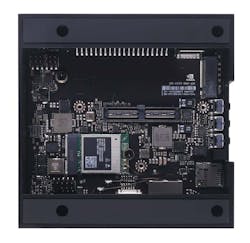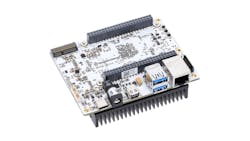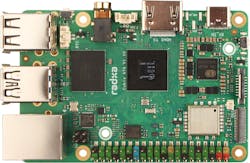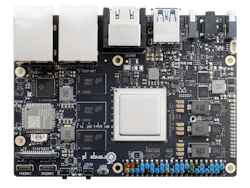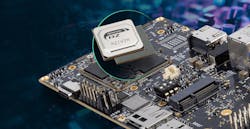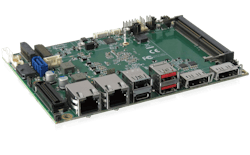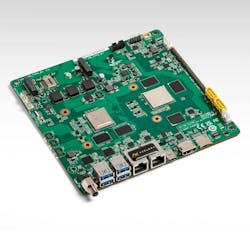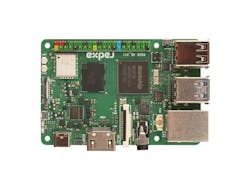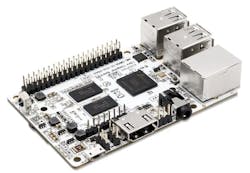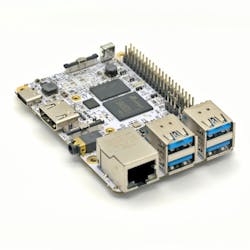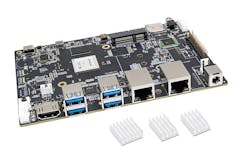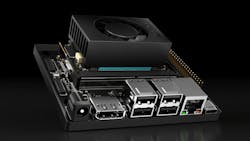These 2025 SBCs Take Advantage of AI Hardware
What you'll learn:
- Insight into AI-focused SBCs that offer the latest processors and NPUs.
- How each board balances compute power, RAM, and expansion.
- What platforms are best suited for edge AI, robotics, and vision applications.
One more post for the "Trust in AI" Takeover Week 2025: What off-the-shelf boards have AI capabilities built in?
AI is shifting from the cloud to the edge, and single-board computers (SBCs) are the latest platforms to leverage local processing. The latest boards aren’t just powerful—they’re outfitted with built-in AI accelerators and neural engines that can tackle everything from machine vision to predictive maintenance in real-time. Whether it's building autonomous drones, smart cameras, or edge-based inference platforms, these boards prove that small doesn’t mean underpowered.
In this roundup, we look at the latest AI-based SBCs currently available or set for release.
- NVIDIA Jetson AGX Orin 64-GB Developer Kit
- BeagleBone AI‑64
- Radxa Cubie A7A
- Orange Pi AIpro (20T)
- IMDT RZ/V2N
- Kontron 3.5″-SBC-AML/ADN
- Axelera Metis Compute Board
- Radxa ROCK 4D
- Libre Computer Alta AML-A311D-CC
- Libre Computer Solitude AML-S905D3-CC
- Banana Pi BPI-F3
- NVIDIA Jetson Orin Nano Super Developer Kit
NVIDIA Jetson AGX Orin 64-GB Developer Kit
The Jetson AGX Orin 64-GB Developer Kit from NVIDIA is designed for AI-driven tasks, including deployment of large language models (LLMs), natural language applications, robotics, autonomous systems, multi-sensor fusion, and more. The kit comes with the company’s Jetson AGX Orin 64-GB module, which is outfitted with a 12-core Arm Cortex-A78AE v8.2 64-bit CPU. It features 2,048 CUDA cores and 64 Tensor cores, capable of producing up to 275 TOPS of AI performance.
The module also features 64 GB of 256-bit LPDDR5 RAM and 64 GB of eMMC 5.1 for storage. Connectivity is handled by Ethernet and optional add-on modules for Wi-Fi and Bluetooth. It also features 22 lanes of PCIe Gen4, 1x 10 GbE, a DisplayPort, 16 lanes of MIPI CSI-2, USB 3.2 interfaces, and a 40-pin header.
BeagleBone AI‑64
BeagleBone’s AI-64 takes advantage of AI to handle everything from autonomous robotics to video analytics. The board comes equipped with Texas Instruments’ TDA4VM SoC with dual Arm Cortex-A72 cores, 4-GB LPDDR4, and 16-GB eMMC flash.
The AI-64 also packs 6x Arm Cortex-R5F MCUs, a 3D GPU PowerVR Rogue 8XE GE8430 (up to 96 GFLOPS), a pair of C66x floating-point DSPs (up to 40 GFLOPS/160 GOPS), a C7x floating-point vector DSP (up to 80 GFLOPS, 256 GOPS) and Depth and Motion Processing Accelerators (DMPACs).
Of course, the BeagleBoard’s AI-64 is outfitted with myriad ports and connectors, including an M.2 E-key PCIe connector for Wi-Fi modules, a USB 3.0 Type-A interface, a USB Type-C interface, Gigabit Ethernet, a Mini DisplayPort interface, 2x 4-lane CSI connectors, and a 4-lane DSI connector. Furthermore, there’s a BeagleBone Black header compatibility for expansion with existing add-on capes, and a mikroBUS shuttle header that provides access to hundreds of existing Click sensors and actuators.
Radxa Cubie A7A
The Radxa Cubie A7A is an upcoming SBC from Radxa that’s powered by an Allwinner A733 octa-core Cortex-A76/A55 SoC. It’s equipped with a 3-TOPS AI accelerator and up to 16-GB LPDDR5 RAM. The board also features an Imagination Technologies BXM-4-64 MC1 GPU, 128 MB of SPI flash, a microSD card slot, and eMMC support.
The Cubie A7A features numerous interfaces, including an HDMI 2.0b port, MIPI FPC connector, MIPI CSI connector, Gigabit Ethernet RJ45 port, and a dual-band Wi-Fi 6 and Bluetooth 5.4 module. It also packs a USB 3.0 host port, 3x USB 2.0 host ports, a USB 2.0 OTG Type-C port, PCIe Gen3 FPC connector, and a 40-pin GPIO header.
Orange Pi AIpro (20T)
The Orange Pi AIpro (20T) is the company’s latest SBC that’s designed for AI applications. The board comes with a Huawei Ascend quad-core 64-bit processor, a DaVinci V300 AI core, and 4x TAISHANV200M processor cores that can deliver up to 20 TOPS. It also features up to 24 GB of LPDDR4X RAM, 32 MB of SPI flash, a microSD card socket, an eMMC flash module connector for up to 256-GB modules, and an M.2 Key-M 2280 socket for NVMe or SATA SSDs.
Networking for the AIpro (20T) includes a Gigabit Ethernet RJ45 port, dual-band Wi-Fi 5 and Bluetooth 4.2 module, along with a pair of antenna connectors. In addition, there are 2x USB 3.0 ports, 1x USB 3.0 Type-C port, and a micro USB port (for UART console) plus 40-pin expansion header.
IMDT RZ/V2N
IMD Technologies recently released its IMDT RZ V2N system-on-module (SOM), based on Renesas’ RZ/V2N low-power AI MPU, along with an SBC carrier board, designed for robotics, industrial automation, IoT applications, and more. The SOM is equipped with a quad-core Arm Cortex-A55 processor, an Arm Cortex-M33 system manager, 8 GB of RAM, and 32 GB of eMMC flash. It also packs a DRP-AI accelerator capable of providing up to 4 dense TOPS and 15 sparse TOPS.
Storage options for the IMDT RZ V2N include 64-MB QSPI NOR of onboard flash, secure EEPROM, and a microSD card slot for additional storage. There’s also a pair of 4-lane MIPI CSI camera interfaces, a 4-lane DSI display with touch interface, and HDMI output via an external DSI-to-HDMI converter. Networking options include 2x Gigabit Ethernet (1000Base-T) RJ45 jacks (with optional PoE), Wi-Fi 4, dual-band Bluetooth 5.2 BR/EDR/LE, and optional cellular connectivity via an M.2 Key-B slot.
Furthermore, the IMDT RZ V2N features a USB 3.2 Type-A connector, USB 2.0 micro-B connector, RS-232 transceiver, CAN-FD transceiver, temperature and humidity sensor, 6-DOF IMU, 3-axis magnetometer, and more.
Kontron 3.5″-SBC-AML/ADN
The 3.5″-SBC-AML/ADN from Kontron is a 3.5-in. SBC driven by either an Intel Amston Lake or Alder Lake-N processor. It’s designed for AI applications, including automation, healthcare, retail, etc. The board comes equipped with an integrated Intel UHD Graphics Gen12 GPU and can handle up to 16 GB of DDR5 4,800-MHz SO-DIMM memory. Storage support includes NVMe or SATA SSD via an M.2 Key-M socket and a SATA 3.0 port for additional storage options.
The AML/AND board also features a 24-bit dual-channel LVDS or eDP port, and 3x DP ports that can drive a triple monitor rig up to 4096 × 2160 (at 60 Hz). Networking is handled by a pair of 2.5 GbE RJ45 ports via Intel I226-V/IT controllers, optional Wi-Fi and Bluetooth via an M.2 Key-E module, and optional 4G LTE or 5G via an M.2 Key-B module plus SIM card holder.
USB ports are plentiful: two USB 3.2 Gen 2 Type-A ports, a USB 3.2 Gen 2 Type-C port, a USB 3.2 Gen 1 Type-C port, and a USB 2.0 Type-A port.
Axelera Metis Compute Board
Axelera describes its Metis Compute Board as a compact, power-efficient SBC and complete IoT platform engineered to run AI applications that require intense compute resources on devices at the edge. The board comes with a Rockchip RK3588 SoC that has an octa-core processor with four Arm Cortex-A76 cores, an Arm Mali-G610 MP4 quad-core GPU, and a quad-core Metis AI accelerator capable of delivering up to 214 TOPS.
Other Metis Compute board features include 16 GB of LPDDR4 for the SoC, and up to 16 GB of LPDDR4x for the AIPU. The board also packs 64 GB of eMMC flash, 2x SATA 3.0 ports, and a microSD card slot for storage options. Among the networking options are 2x Gigabit Ethernet RJ45 ports and optional Wi-Fi, Bluetooth, and 4G LTE via M.2 sockets. USB ports include 4x USB 3.1 Gen1 Type-A ports, a USB 3.2 Type-C port with DisplayPort Alt. mode, and 3x headers for 6x USB 2.0 ports.
Radxa ROCK 4D
Radxa’s ROCK 4D is another AI-leveraging SBC designed around Rockchip’s RK3576 SoC, offering a similar form factor to the Raspberry Pi 3 with the standard 40-pin GPIO header. The board incorporates four Cortex-A72 cores and four Cortex-A53 cores, up to 16 GB of LPDDR5 RAM, and an Arm Mali-G52 MC3 GPU capable of delivering up to 6 TOPS.
The Rock 4D has a connector for an eMMC 5.1 flash module, a UFS 2.0 flash module connector, and an optional M.2 NVMe SSD via a compatible PCIe HAT for various storage options. It also comes with a 4-lane MIPI CSI connector, a 2-lane MIPI CSI connector, a Gigabit Ethernet RJ45 port with optional PoE support, Wi-Fi 6, and Bluetooth 5.4 (FCU760K module), plus two USB ports. Additional features include 2x USB 3.0 Type-A ports (including one OTG port), 2x USB 2.0 Type-A host ports, a 40-pin Raspberry Pi-compatible GPIO header, and more.
Libre Computer Alta AML-A311D-CC
Libre Computer’s Alta AML-A311D-CC is the company’s second-generation Cottonwood hardware platform, featuring an AI accelerator for multipurpose applications. The board is designed around the Amlogic A311D hexa-core Arm Cortex-A73/A53 processor (with a 5-TOPS AI accelerator) that comes equipped with an Arm Mali-G52 MP4 GPU, 4 GB of LPDDR4 RAM, and 16 MB of SPI NOR flash for storage.
The board also features an eMMC 5.x flash module connector and a microSD card slot with UHS SDR104 for storage expansion. It also packs a 4-lane MIPI CSI via 22-pin connector, a Gigabit Ethernet RJ45 port with optional PoE support, 4x USB 3.0 Type-A ports, and a USB 2.0 OTG Type-C port with USB PD support.
Libre Computer Solitude AML-S905D3-CC
Libre Computer’s AML-S905D3-CC Solitude is another AI-driven board designed to take advantage of a wide range of compute and neuro-AI workloads. The board comes outfitted with an Amlogic S905D3 SoC, which packs 4x Arm Cortex-A55 cores, a Mali-G31 MP2 GPU with 1.2-TOPS AI Accelerator, and up to 4 GB of LPDDR4 RAM.
The Solitude incorporates Gigabit Ethernet with optional PoE support, a USB 2.0 Type-C dual-role-data port with 5V3A power support, 4x USB Type-A ports, a microSD card slot, an eMMC module interface, and a 40-pin GPIO header. The board also features connectors for MIPI Display Serial Interfaces and Camera Serial Interfaces (DSIs and CSIs).
Banana Pi BPI-F3
The BPI-F3 SBC developed by Banana Pi is designed around a SpacemiT K1 octo-core X6 RISC-V processor and an Imagination IMG BXE-2-32 capable of 2.0-TOPS AI computing power. The board packs up to 16 GB of LPDDR4 RAM, up to 16 GB of eMMC flash, 32 MB of SPI NAND flash (optional), and 4 MB of SPI NOR flash (optional).
The BPI-F3 also features a pair of Gigabit Ethernet RJ45 ports, supported by Realtek RTL8211F transceivers, with support for PoE via the RT5400 expansion board. In addition, there’s a dual-band 2.4-/5-GHz Wi-Fi 5 and Bluetooth 4.2 interface, provided by a Realtek RTL8852BS module, and optional 4G LTE support via an mPCIe socket and SIM card slot. Also in the mix are 4x USB 3.0 Type-A ports via a VL817 USB 3.0 hub, a single USB 2.0 Type-C OTG port, an M.2 Key-M socket, a single mPCIe socket, and a 40-pin GPIO header.
NVIDIA Jetson Orin Nano Super Developer Kit
Another entry from NVIDIA, the Jetson Orin Nano Super Developer Kit, is an upgrade to the company’s original Orin Nano Developer Kit, providing 1.7X more performance at about half the price. Its 70% increase in performance works out to 67 INT8 TOPS. The Orin Nano 8-GB module comes with a 6-core Arm Cortex-A78AE v8.2 64-bit processor, an NVIDIA Ampere architecture GPU with 1,024 CUDA cores and 32 tensor cores, and 8 GB of LPDDR5 RAM.
The Jetson Orin Nano Super Development Kit also packs SD card and NVMe SSD interfaces, a microSD slot, 2x M.2 sockets for NVMe SSDs, 2x 22-pin MIPI CSI-2 camera connectors, a Gigabit Ethernet RJ45 port, and optional Wi-Fi and Bluetooth via an M.2 Key-E slot. On top of that, there are 4x USB 3.2 Gen2 Type-A ports, a USB Type-C port for UFP, an M.2 Key M slot with PCIe Gen3 x4, an M.2 Key E slot, and a 40-pin GPIO header.
Conclusion
AI-enhanced SBCs are no longer on the horizon—they’re already here. With built-in support for neural-network processing, high-speed connectivity, and enough horsepower to crunch massive datasets locally, these boards are pushing innovation beyond the boundaries of what’s achievable with simple development boards.
As AI continues to evolve, we can expect these platforms to become even more powerful, more efficient, and more deeply integrated into everything from industrial automation to consumer robotics.
About the Author
Cabe Atwell
Technology Editor, Electronic Design
Cabe is a Technology Editor for Electronic Design.
Engineer, Machinist, Maker, Writer. A graduate Electrical Engineer actively plying his expertise in the industry and at his company, Gunhead. When not designing/building, he creates a steady torrent of projects and content in the media world. Many of his projects and articles are online at element14 & SolidSmack, industry-focused work at EETimes & EDN, and offbeat articles at Make Magazine. Currently, you can find him hosting webinars and contributing to Electronic Design and Machine Design.
Cabe is an electrical engineer, design consultant and author with 25 years’ experience. His most recent book is “Essential 555 IC: Design, Configure, and Create Clever Circuits”
Cabe writes the Engineering on Friday blog on Electronic Design.

